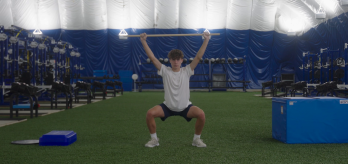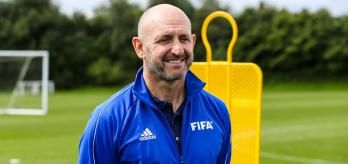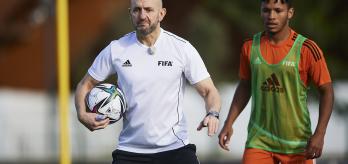Defined as the ability to move freely and easily, mobility is an essential but somewhat undervalued component of player development. The focus here is not on the leg swings, kicks, skips and flicks commonly seen during a warm-up before the footballs are brought out. Rather, the focus is on purposeful and dynamic mobility; coordination between interconnecting muscles and joints to perform functional athletic movements with ease and control through a full range of motion. This can be developed by implementing exercises that challenge different aspects of mobility.
In this series, we provide a number of simple start-up exercises to be used for pre- and post-training dynamic mobility. Some of them are to be used during an activation to prepare players for training, while others focus on development by maintaining and improving joint movements and working towards a full range of motion. The exercises require purposeful, coordinated and controlled actions, with sequences that activate the muscles involved in dynamic football movements. There is a particular focus on the hip, pelvis and spinal joints and muscles in coordination with lower- and upper-limb movements.
We are born to be mobile, but the cliché “use it or lose it” is particularly appropriate when it comes to mobility, given that it tends to deteriorate throughout a person’s life. This is first seen during puberty (if there is no intervention), followed by a sedentary lifestyle and the repetitive stress of unbalanced movements and ageing, which are the main culprits for further decline and dysfunction. From a development perspective, the objective is to nurture mobility from an early age to help establish a functional base for athleticism to flourish. Targeted exposure to dynamic mobility is key. This can be achieved by executing sequences that challenge collective coordination and connectivity between multiple muscles and joints through a full range of motion.
Exercise details
Joint and muscle focus
- Hip flexors, adductors and rotators
Execution
- Keep feet turned out horizontally during execution
Joint and muscle focus
- Hip internal rotators
Execution
- Lift the foot, squeeze glutes and hold briefly at top position
Joint and muscle focus
- Hip adductors and extensors
Execution
- Keep extended leg straight, with the ball of the foot in complete contact with the floor
- When rocking back to full range, briefly hold the stretch before returning to starting position
Joint and muscle focus
- Hip flexors and external rotators
Execution
- Lift the knee to the fullest extent, holding briefly at top of movement
Joint and muscle focus
- Internal and external hip rotators
Execution
- Try to sit upright if possible as you shift from one side to another
Joint and muscle focus
- Active hip flexors and extensors, internal and external rotators, with strong core activation to maintain aligned posture
Execution
- Try to maintain a straight back by engaging core muscles during execution
- Keep arms completely extended with chest out
- When in the bridged plank position, do not allow hips to drop towards the floor
- Keep the rear leg extended and off the floor.
Joint and muscle focus
- Active hip flexion and adduction, with strong core activation to maintain aligned posture
Execution
- Try to maintain a straight back by engaging core muscles during execution
- Touch the foot to the floor in a controlled manner when extending the leg out wide
- Keep arms completely extended with chest out
- When in the bridged plank position, do not allow hips to drop towards the floor
- Keep the rear leg extended and off the floor.
Joint and muscle focus
- Hip flexors and extensors, lumbar spine muscles
Execution
- In the extended lunge position, keep the back in a neutral position (not arched or bowed forwards)
- In the extended hamstring position, lean slightly forwards from the hip while maintaining a neutral spine position. Keep a straight back, with chest out and head up.
- Keep the extended leg straight and dorsiflex the ankle (toes towards the shin).
Joint and muscle focus
- Hip extensors and rotators, spinal extensors, ankle flexors and shoulder extensors, with strong core activation to maintain posture
Execution
- Stand with feet wider than shoulder width
- Keep arms fully extended and above the head while squatting
- Squat deep into the hips with chest out, engage the core to help keep the spine in a neutral position. Keeping the feet turned out slightly and with the head lifted, try to draw the pole backwards so that it is in line with or behind the head.
Joint and muscle focus
- Hip extensors and rotators, spinal extensor and rotators, ankle flexors and shoulder extensors, with strong core activation to maintain posture
Execution
- Sit deep with feet wider than shoulder width
- Engage the core and spinal muscles to maintain a neutral position
- Reach high and rotate the spine as you look high towards extended arm
- Always keep feet in full contact with the floor
- Actively drive your knees out wide
Joint and muscle focus
- Spinal extensors and rotators, hip adductors and flexors, shoulder horizonal flexors and neck rotators
Execution
- Try to keep a stable and balanced lunge position, keeping your forward knee facing straight ahead as you rotate 180° from one side to the other
- Keep your arms extended and at shoulder height
- Turn your head to look along the arm reaching backwards
Joint and muscle focus
- Hip adductors and extensors, spinal extensors and ankle flexors, with strong core activation to maintain aligned posture
Execution
- Keep the back in a neutral position as you lunge to either side
- Aim for a full range of motion, with your chest out and head up
- As you sit deep, try to position your torso so that it is in line with the knee that you lunge towards
- Try to keep the ball of both feet in contact with the floor
Joint and muscle focus
- Hip flexors and extensors, internal and external rotators, spinal rotators (thoracic emphasis), horizontal shoulder flexors and ankle flexors, with strong core activation to maintain aligned posture
Execution
- While in an extended lunge position, do not allow the hips to drop towards the floor and keep the rear leg extended and off the floor
- The support hand should align with your front foot. Engage your core as you rotate the upper body and reach high with a big arc to extend the arm. Hold briefly at top
Implementation
Football involves arguably the most frenetic movements of any sport, so a good physique is essential to not only stand out from the crowd but also cope with the repetitive exertion. Movements that are pivotal to the game, such as reactionary acceleration and deceleration and rotational changes of direction, can be performed more effectively if a player has fundamentally strong mechanics. The mobility of the hips, pelvis and spinal muscles and joints are integral in that regard.
Exercises that target a full range of motion in those key areas can unlock the potential to develop incredible efficiency on the pitch. That is because fluid motion helps facilitate optimal movement patterns, enabling efficient coordination and connectivity between the muscles and joints involved in producing dynamic movement. This in turn gives rise to enormous potential for developing athleticism, especially if mobility training is initiated from an early age and in tandem with age-appropriate athletic movements that target strength and control through a full range of motion. Such an approach is critical to forming the roots of athleticism, because regular and personalised training establishes life-long neural and muscle connections (dynamic pathways) that provide a fantastic platform of efficiency to develop and express outstanding dynamism on the pitch.
- If you are training dynamic mobility before a regular football session, it makes sense to work through a repertoire of 8 to 9 exercises, performing 6 to 10 repetitions each over roughly 10 minutes. In this scenario, no other form of athletic training should precede football practice.
- If you opt for a shorter series of 6 exercises with 5 to 6 repetitions (lasting around 5 to 10 minutes), it becomes possible to follow this with an additional mode of athletic training before starting football practice.
- If you prefer to carry out your dynamic mobility work after a football session, you should aim for up to 20 minutes, completing two sets of 8 to 10 exercises with 10 to 15 repetitions each. This can be done after football training, after any other athletic training, or as a standalone session.
Summary
Highly functional mobility provides the bedrock for efficient movement, power and countering or absorbing the physical pressure caused by frenetic movements in football. It also offers a number of benefits for player development:
- Acts as a catalyst for agility
- Reduces stress on muscles, joints and soft tissue from excessive loads
- Helps prevent muscle imbalances caused by compensatory movements or asymmetrical dominance
- Helps distribute loads efficiently, protecting against the development of weak or stress points in muscles, tendons and joints
- Helps with recovery after high-intensity training
- Helps strengthen the core muscles
- Increases joint integrity and the mobility of soft tissues around the joints
Collectively, these benefits enable players to express their dynamism on the pitch while simultaneously reducing the chance of injury.
Flexibility and mobility are interrelated and both are relevant when it comes to dynamic mobility exercises. Flexibility is the ability for muscles and connective tissue to passively stretch. Mobility is the ability to move a joint through its full range of motion, requiring strength and control.

















